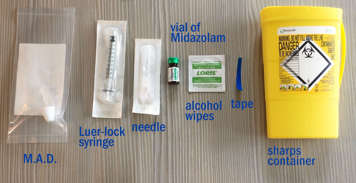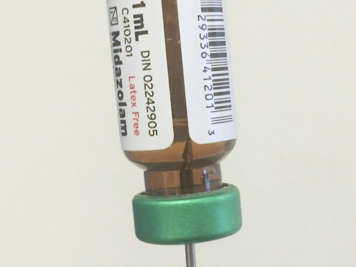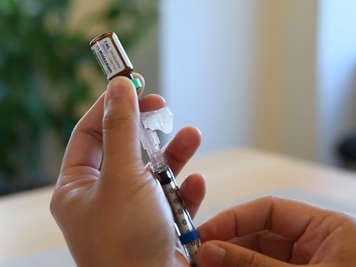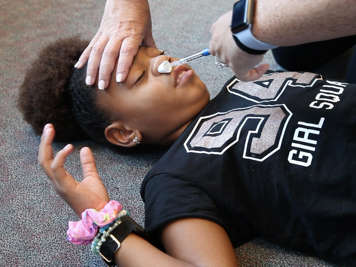Your child has been prescribed a medication called midazolam that is given into the nose (intranasally). This information sheet explains what midazolam does, how to give it, and what side effects or problems your child may have when they take this medication.
What is midazolam?
Midazolam is used to quickly stop seizures. Talk to your child's doctor or pharmacist to make sure you understand why your child may need midazolam. Midazolam comes in a glass vial. This family med-aid explains how to give midazolam as a mist into the nose using a device called a mucosal atomization device (MAD). You may also hear it called a nasal atomizer or an M.A.D.
Before giving midazolam to your child
Your child should not be given midazolam if they have:
- an allergy to midazolam or anything else in midazolam
- an allergy to benzodiazepine drugs like diazepam or lorazepam
- a disease called acute narrow angle glaucoma
Tell your child's doctor or pharmacist if they have any of the following conditions. This medication may not be right for your child if they have:
- liver or kidney disease (a dose adjustment in midazolam may be needed)
- lung disease (midazolam can worsen breathing problems)
- heart disease
How should I give my child midazolam?
- Give your child this medication exactly as their health-care provider or pharmacist tells you to.
- This medication should only be given when your child needs it. Midazolam is often used to stop a long seizure or a cluster of seizures. Speak to your child’s health-care provider or pharmacist about when you should give this medication to your child.
- Give this medication into the nose using the MAD.
What is intranasal medication administration?
Intranasal medication administration is when medications are given directly into the nose. When the medication is sprayed into the nose, it is quickly absorbed through the inner surface of the nose directly into the blood. This works quickly to stop a seizure.
Preparing the dose:
You will need:
- a MAD
- a Luer-lock syringe
- a needle
- a vial of midazolam
- alcohol wipes
- a piece of tape to mark the amount you will withdraw
- a sharps container

Before starting, you may find it helpful to mark the syringe with tape or a marker at the level where the medication needs to be drawn up to. Your child’s health-care provider or pharmacist will tell you the volume of medication your child needs and what level this is in milliliters (mL). Note that an extra 0.1 mL of medication should be drawn up to account for the amount of liquid medication that will remain in the neck of the MAD after administering the dose. For example, if the dose is 0.5 mL of medication, 0.6 mL needs to be drawn up.
It is important that you check with your pharmacist or other health provider for the exact volume of extra medication to draw up before giving the dose. There are different models of MADs and the volumes may vary.
How to draw up midazolam from a vial:

- Fill the syringe with air by pulling the plunger of the syringe back until the top of the plunger reaches the marked level (the volume of medication your child needs plus the extra volume needed to account for the amount of liquid drug that will remain in the neck of the MAD).
- Check to make sure the medication is Midazolam, that it has the correct dose and that it hasn’t expired. Remove the protective plastic cap off the vial of medication and wipe the top of the vial with an alcohol swab.
- Connect the needle to the syringe and twist to secure.

- Remove the needle cap and stick the needle through the rubber seal of the medication vial.
- Push on the plunger of the syringe to inject air into the medication vial.

- Flip the vial with the syringe in it upside down. While holding down the plunger, look into the vial to make sure the tip of the needle is in the liquid medication. If it is not, adjust the level of the needle so that the needle tip is fully in the liquid.

- Pull back on the plunger and allow the syringe to fill with medication. Draw up the medication until it reaches the marked level. If you notice large air bubbles in the syringe, tap the syringe to bring the bubbles to the top, flip the vial with the syringe in it back over, inject all the medication back into the vial and restart from step 6.
- When you have the correct amount of medication drawn up, remove the needle from the vial.
- Replace the needle cap and twist off the needle from the syringe.
- Safely dispose of the needle in a sharps container.
How to give midazolam using a MAD

- Attach the MAD to the syringe and twist to secure.
- Examine the inside of your child’s nose. Look for large amounts of mucous or blood that may prevent absorption of the medication into the nose and remove if possible. Talk to your child’s health-care provider about how you can remove excess mucous or blood, if needed, prior to using the MAD.
- Make sure your child is lying down on their back.

- Hold the top of your child’s head as still as possible and place the MAD into their nostril. The tip of the MAD should rest snugly against the insides of the nostril and should be aiming up and outwards.

- Push down on the plunger of the syringe forcefully to expel the medication as a mist into the nostril in one rapid dose. If pushed too slowly, medication may not turn into a mist and may not work as effectively.
- Move your child to make sure they are lying down in the recovery position.
- There is a maximum dose that can be given per nostril. If your health-care provider has advised you to split the dose, please do so.
- Midazolam usually starts working within 5 minutes.
Repeating a dose
Your child’s health-care provider may decide that it is safe to repeat a dose of midazolam. You should only repeat a dose if instructed to do so by your child’s health-care provider.
If you need to repeat a dose, the extra volume of medication remaining in the device should be discarded first. With the MAD attached, pull back on the plunger to the 1 mL mark to fill the syringe with air, and then push down on the plunger forcefully to push the remaining medication out of the device. Repeat a few times to make sure all medication is pushed out.
Then follow the instructions above to draw up and administer the next dose.
Cleaning and storing the MAD
The device may be washed and reused by the same child. Remove the MAD from the syringe. Wash your hands and the device with mild soap and water. You can use the syringe to rinse the MAD and then let it air dry. Once everything is dry, place it into the safe storage container.
Storing midazolam
- The vial of midazolam must be kept in a dry and clean , at room temperature, away from sunlight. Do NOT store it in the refrigerator, bathroom or kitchen.
- Keep it out of your child’s sight and reach and locked up in a safe place. Some families use a safe storage container.
- Once opened, a vial of midazolam can continue to be used for up to 28 days. After 28 days the vial must be discarded, even if there is still some midazolam remaining. Take your expired midazolam to your pharmacy for disposal. You may want to write down when the vial is first opened.
- Make sure you always have enough midazolam to last through weekends, holidays and vacations.
- You may want to prepare a travel pack of the medication to keep in your purse or at your child's school. It should include all the necessary supplies, such as the medication, the MAD device, a needle, syringe, the alcohol swabs, etc.
- Call your pharmacy at least two business days in advance if you are running low on midazolam, as not all pharmacies will carry this medication on a regular basis.
What are the possible side effects of midazolam?
This medication may make your child drowsy, dizzy or less alert than normal. Rarely, a child may become hyperactive or irritable (grumpy) . Check with your child's doctor if your child continues to have any of these side effects, they do not go away or they bother your child.
When should I contact my doctor?
Most of the following side effects are not common, but they may be a sign of a serious problem. Call 911 or take your child to the nearest Emergency Department if your child has any of the following side effects:
- trouble breathing
- shortness of breath
- severe weakness
- difficulty waking up
- chest pain or pressure
- slurred speech
- confusion
- seizures that do not stop
If your child takes too much Midazolam, call your local Poison Centre.
What safety measures should you take when your child is using midazolam?
Check with your child’s doctor or pharmacist before giving them any other medications (prescription, non-prescription, herbal or natural health products). Midazolam does not work well with some medications, such as cough and cold medications, and medications that contain alcohol.
If your child has been prescribed other rescue medications to quickly stop seizures such as lorazepam (Ativan) or diazepam (Diastat), please check with your doctor or pharmacist before using midazolam. In most cases, your child should only be receiving one kind of rescue medication for seizures.
Midazolam should not be given to your child unless it has been prescribed to them by their health care provider. Make sure you give this medication to your child exactly as you have been told to by your child’s health-care provider or pharmacist. Remember, they are available to answer any of your questions about your child’s medications.
What other important information should you know about midazolam?
Keep a list of all medications your child is on to show the doctor or pharmacist.
Do not share your child’s medication with others. Do not give anyone else’s medication to your child.
Make sure you always have enough midazolam to last through weekends, holidays and vacations. Call your pharmacy at least two business days in advance if you are running low on midazolam as not all pharmacies will carry this medication on a regular basis.
Do not keep any medications that are expired. Check with your pharmacist about the best way to discard outdated or leftover medications.
Keep midazolam out of your child’s sight and reach and locked up in a safe place. If your child takes too much midazolam, call the Ontario Poison Centre at one of these numbers. These calls are free.
- Call 416-813-5900 if you live in Toronto.
- Call 1-800-268-9017 if you live somewhere else in Ontario.
- If you live outside of Ontario, call your local Poison Information Centre.
Disclaimer: The information in this Family Med-aid is accurate at the time of printing. It provides a summary of information about midazolam and does not contain all possible information about this medication. Not all side effects are listed. If you have any questions or want more information about midazolam, speak to your health-care provider.
Keep out of your child’s sight and reach and locked up in a safe place. If your child takes too much , call your local Poison Information Centre at one of these numbers. These calls are free.
- Call 1-844 POISON-X, or 1-844-764-7669, from anywhere in Canada except Quebec.
- Call 1-800-463-5060 if you live in Quebec.